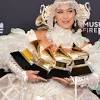House of the Dragon: Blood and Cheese Murder Explained


Without the source material’s Sophie’s Choice torment, it’s just another scene of violence in a show full of scenes of violence. Photo: HBO
Spoilers for the House of the Dragon season-two premiere, “A Son for a Son,” and relevant portions of George R.R. Martin’s books Fire & Blood and The World of Ice & Fire.
Mark this day down for the unlikely words I am about to type: The child-murder scene in the House of the Dragon season-two premiere, “A Son for a Son,” should have been more base and barbaric. Simply killing a child offscreen isn’t enough. Let me explain!
For all of HOTD’s explicitness — crabs and crows feasting on corpses, fully nude sex scenes, age-gap incest, that time we saw the decayed half of King Viserys’s face — it’s been steadfastly subdued when it comes to violence involving children. We didn’t see Prince Lucerys’s body ripped apart after Aemond and Vhagar chomped him, nor did we spend too much time with the underage fighters in Flea Bottom (unlike Aegon). There’s conservative wisdom in leaving George R.R. Martin’s most depraved descriptions of, say, child prostitutes on the page and off the screen. But the changes HOTD made to the source material when it comes to Blood and Cheese’s attack on the royal family are anticlimactic — not because they denied us a glimpse of the brutality inflicted upon Jaehaerys’s body, or excluded the rape threats Cheese made to the boy’s twin sister, but because the scene as written in Martin’s Fire & Blood and The World of Ice & Fire has a level of emotional agony and reckless cruelty that HOTD fails to re-create. Without Helaena’s Sophie’s Choice torment of being forced to choose which child she’s going to save and which she’s going to let die, it’s just another scene of violence in a show full of scenes of violence.
As the war between Teams Black and Green heats up, HOTD has deviated from Martin’s books to suggest that the conflict’s major moments were a series of accidents. Alicent misunderstands Viserys’s use of the name “Aegon,” assuming he wanted their firstborn son to rule instead of Rhaenyra; Aemond describes Vhagar’s murder of Lucerys as unintentional. Now, Daemon sends Blood and Cheese to kill Aemond in retaliation, with the series cutting away from Daemon’s negotiations with the assassins before we see his answer to whether they should kill other members of the royal family if they can’t find Aemond. This storytelling approach keeps the characters from becoming too villainous, creates intrafamilial tension when members of the same team disagree with each other’s choices, and positions the characters as antiheroes we can root for in line with HOTD’s “all must choose” marketing. But it also makes these characters look like they don’t know what they’re doing, an approach that undermines Daemon in particular, sapping his commission of Blood and Cheese of the nefariousness it has in the text. This man murdered his first wife in cold blood, and you’re making one of his most heinous decisions a “whoops”?
In Fire & Blood, Daemon isn’t interested in going after Aemond (at this point, anyway), nor does he go to King’s Landing himself. Daemon knows the more devastating play is taking out one of Aegon’s heirs as Aemond took Rhaenyra’s. From Harrenhal, Daemon sends a message to the Black Council on Dragonstone (“An eye for an eye, a son for a son. Lucerys shall be avenged”) and taps Mysaria, who is still in the capital, to find two appropriate mercenaries. Martin writes of the two men, “One had been a serjeant in the City Watch; big and brutal, he had lost his gold cloak for beating a whore to death whilst in a drunken rage. The other was a ratcatcher in the Red Keep. Their true names are lost to history. They are remembered (would that they were not!) as Blood and Cheese.” “A Son for a Son” slides into horror-movie mode once Daemon sneaks into the city to enlist the pair. Director Alan Taylor’s camera floats alongside them and their dog assistant as they make their way through the Red Keep’s claustrophobic sewers and shadowy staircases. The lighting provided by their fiery torches is stark and vivid, while Ramin Djawadi’s score evokes a frantic caterwaul. As soon as Blood and Cheese enter Helaena’s quarters, though, the scene screeches to a dramatic halt.
In Martin’s writing, Helaena and Aegon have three children: 6-year-old twins Jaehaerys and Jaehaera and 2-year-old son Maelor. The crux of the Blood and Cheese scene, what makes it so sickening and what provides it with agonizing impact beyond merely the death of a child (which we’ve already seen tons of in this story), is that the self-described “debt collectors” make Helaena choose which of her sons is going to live — and then kill the son she opted to save instead of the one she fingered for death. This whole exchange is only a couple paragraphs long, but it is packed with horrific details that linger in one’s memory: “On her knees, weeping, Helaena named her youngest, Maelor. Perhaps she thought the boy was too young to understand, or perhaps it was because the older boy, Jaehaerys, was King Aegon’s firstborn son and heir, next in line to the Iron Throne. ‘You hear that, little boy?’ Cheese whispered to Maelor. ‘Your momma wants you dead.’ Then he gave Blood a grin, and the hulking swordsman slew Prince Jaehaerys, striking off the boy’s head with a single blow. The queen began to scream.”
Helaena’s desperation and shock at her elder son’s death, Maelor’s knowledge that his mother picked him to die, Jaehaera old enough to understand everything going on, Helaena having to live with what happened — it’s a macabre menagerie that emphasizes exactly how ruinous this war will be. There will be intentional decisions made within Teams Green and Black that will tear families apart and haunt them for generations. House of the Dragon’s adaptation, while effective in its use of limited perspective (we only hear Blood and Cheese sawing off Jaehaerys’s head, a nightmarish squelching sound design), doesn’t hit as much emotionally as it does visually and aurally.
In the series, Aegon and Helaena have only the aged-down twins Jaehaerys and Jaehaera. Phia Saban has been solidly spooky as Helaena in the series’ reimagining of her as somewhat clairvoyant (her line delivery of “I’m afraid … not the dragons, the rats” is solid foreshadowing), but when faced with Blood and Cheese, the scant dialogue underserves her. She’s rigid and barely speaks, offering her necklace as barter before quickly identifying Jaehaerys. Neither reaction feels as intense as this scene needs, and there’s no attempt from her to save her son, even though she knows he’s the kingdom’s only male heir.
This isn’t to suggest that the only valid emotions in a traumatic situation are big, exaggerated ones. However, since Helaena’s marriage to Aegon, HOTD has primarily coded her as a mother; giving her the impossible choice from the text would have accentuated whatever conflicted, pressured, or dutiful feelings she has about motherhood and her children. Without the terrible choice to bring her into sharper focus, and without more proactivity from Helaena in the episode, this scene passes by without the acute there’s no turning back from this feeling it should have. There should be magnitude and mania (in the novels, Helaena basically goes insane from the guilt of her choice, and Alicent takes over raising Maelor) and a suggestion not just for what the death of Jaehaerys will mean for Aegon (who gets a requisite “I love my son” scene earlier in the episode), but for Helaena, too, whose involvement so far in this war — and the series, for that matter — has felt fairly ancillary.
It’s odd, then, that “A Son for a Son” chooses to end not on Helaena’s grief or a personalized sense of her loss (“They killed the boy” is weirdly cold, even accepting, phrasing, isn’t it?), but on the confused face of Alicent, caught having sex with Kingsguard Lord Commander Criston Cole (a dalliance that perhaps led him to ignore his security duties, allowing Blood and Cheese to slide in). Alicent and Cole’s oath-breaking relationship serves as another gaffe HOTD is weaving into its tapestry of accidental conflict escalation, but the mistake the show makes is diminishing the details that elucidate Blood and Cheese’s viciousness, and the deliberate calculations of the man who sent them. Without them, what should be one of House of the Dragon’s most infamous scenes minimizes the guilt and grief of everyone involved.
See All

 United States
United States Argentina
Argentina  Australia
Australia  Austria
Austria  Brazil
Brazil  Canada
Canada  Chile
Chile  Czechia
Czechia  France
France  Germany
Germany  Greece
Greece  Italy
Italy  Mexico
Mexico  New Zealand
New Zealand  Nigeria
Nigeria  Norway
Norway  Poland
Poland  Portugal
Portugal  Sweden
Sweden  Switzerland
Switzerland  United Kingdom
United Kingdom 


















